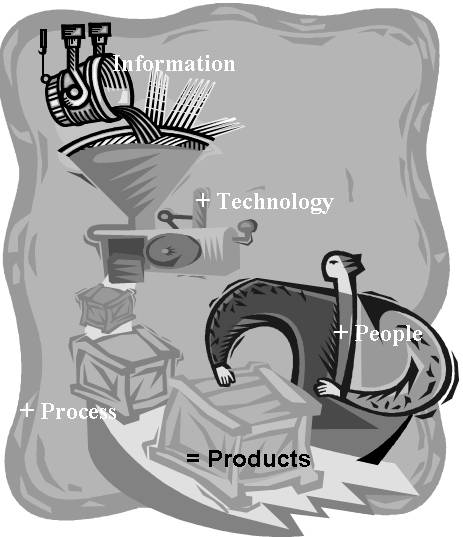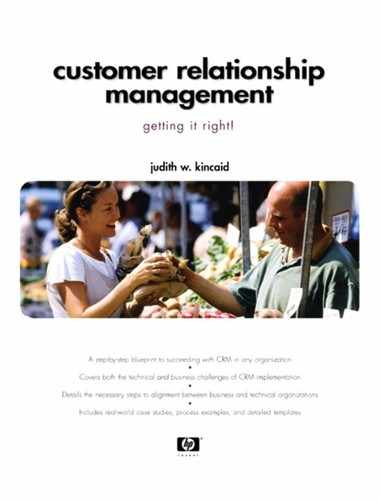3.1. Defining “CRM”
We're going to establish a definition of the term CRM that we will use throughout the rest of this book. Just before we do that, let's take a look at some of the misconceptions and partial truths that exist about CRM.
Creating a definition for CRM is both critical and dangerous. It is critical because your organization needs to have a common understanding of what you are doing. It is dangerous because so many definitions and misconceptions are already lodged in people's minds. One of the first things that any company should do when launching a CRM initiative is to test what the organization's current understanding of CRM is.
3.1.1. Common Misconceptions
Table 3-1 presents a series of quotes from a number of different individuals, all within the same company. These are great examples of the common misconceptions of CRM. (Conflicting statements often come from different individuals within the same company.)
| Misconception | Reality |
|---|---|
| “CRM is the solution that will solve all our customer problems; it's all the software tools that make it easier for a customer to do business with us.” | Absolutely not. There is no magic, no sorcerer's stone, and no silver bullet. This effort takes vision, planning, investment, and patience. Software is certainly a necessary enabler, but not the total solution. The trouble with the magic software myth is that it allows business managers to think CRM is just an Information Technology problem. Application software vendors not surprisingly, abet this common misconception. If it were that easy, why wouldn't everybody be doing it already? |
| “CRM is the Internet.” | The Internet has greatly increased the opportunity and need for better information, tools, and the processes that can take advantage of them. But relationships are built on understanding and trust. People who understand the customer's perspective must be the ones who design the web experience. |
| “CRM is just the latest name for Direct Marketing.” | Using information and automation to understand and improve customer relationships has been practiced by Direct Marketers for years. CRM is a shift in focus from marketing (communicating “to”) to relationship management (communicating “with”). |
| “CRM means recognizing a customer wherever he interacts with our company, a 360° view of the customer.” | This is a critical first step, but simple recognition isn't enough. We must learn to use the information we've collected in the past to interact effectively in each future interaction. Information about customers is critical to increased understanding and improved service. You also need tools and training so people know what to do with it. |
| “CRM means scoring and measuring Customer Value.” | A very important use of CRM information is to be able to identify who our best customers are. We must have ways to use this knowledge to increase the number of loyal customers and the value of each. |
| “CRM is sales rep productivity tools.” | Some companies still believe that the only way they can build relationships is through the sales force, so CRM must be about automating sales. The sales function is only one of those that directly touch customers and make up CRM. |
None of these statements is totally wrong, but none tells the complete story. CRM is not just the Internet or just sales rep productivity; it is an entire discipline for interacting with customers that touches all the front office functions.
3.1.2. Definition
Here is the definition of CRM that we will use throughout the rest of this book. The definition includes all the elements that make up the CRM supporting infrastructure and all the functions that must be involved.
|
This definition of CRM is quite broad and covers many, but not all, of your company's activities. CRM is limited to activities that take place in the customer-facing functions, including marketing, sales, customer services, and product support. CRM does not equal customer centricity. Frankly, although it's harder, you can implement a CRM program even in a company that is not customer-centered. CRM is not all-inclusive. Your company may choose to develop a customer-centered R&D process, but this new process would not be part of your CRM program. As we discussed in Chapter 2, CRM is limited to the front office functions. However, there is no doubt that the new R&D program would need customer information, which is generated by your CRM functions.
We are using this broad definition so that we can develop a framework that covers all the functions and components needed to build your CRM solution. Let's take a look at the key elements of the definition:
CRM focuses on strategic impact rather than operational impact. Benefits are generally long term rather than immediate (future increased profit rather than immediate cost reduction). This doesn't mean that you shouldn't sell your program with some up-front cost-reductions proposals. It means that you need to understand where the benefits will really occur and set realistic expectations.
CRM is a total discipline. To understand CRM, think of it as having the same components as any manufacturing business. It uses a machine (CRM technology) and power (your people) to turn raw material (customer information) into products (processes and interactions that build customer loyalty).
CRM includes all the functions that directly touch the customer throughout his entire lifetime with your company. It touches multiple organizations and crosses boundaries. Functions usually included in a CRM effort are marketing, sales, customer services, and product support (whether internal or through a channel partner, whether on or off the web).
The components of the CRM total discipline are shown in Figure 3-2.
Figure 3-2. CRM is a total discipline.

If you already hold a strong belief about what CRM means it may be hard to buy into a new one. Your brain will read “CRM” and automatically switch back to the definition you're familiar with. But please keep this definition in your mind as you're reading the rest of this book. The CRM that we're talking about is the CRM we've just defined. This definition covers all the important elements that you have to implement in a successful program. No matter what you call your effort or how you choose to implement the components within your own company, this is the definition that covers what customer relationship management really is. For example, maybe for you, as a dotcom company CRM is just about the web. Or maybe “CRM” has been tried before and failed, so you need a fresh term to rekindle enthusiasm. These kinds of special situations don't change the basic concept or what needs to get done, but you do have to make it your own.
Always remember that when you're getting started within your own company, you must have a clear understanding of what CRM is (even if it isn't this definition) and get universal agreement from everyone involved; otherwise, you will never get your company moving in a focused direction. You will have difficulty showing progress and measuring success without a universally understood goal and understanding. Lack of a clear definition puts any new program in a very high-risk position, and CRM is no exception. Also, don't forget that you'll likely have to repeat and reconfirm these terms and definitions frequently throughout the life of the program. Otherwise, you can't ensure that your management, your sponsors, and your team continue to understand and support your direction. I learned the hard way, so believe me when I say that it's almost impossible to repeat your purpose and goal too often.
It is also important to understand that your company does not need to implement a total CRM solution across your entire front office organization before you have succeeded at CRM. Because the CRM concept sounds so big and broad, we will look at ways to identify and prioritize small chunks that can yield quick success and build on each other to deliver your overall goal. CRM must be approached as an ongoing evolution in which the cost of each new project is weighed against the value for the customer (and, thus, the benefit for your company through increased revenue and reduced costs). Even though our definition of CRM is broad and complex, its goal is simple: to maximize the value of your company's customer asset including loyalty, revenue, and profit.
3.1.3. The Components of CRM
As our definition states, the CRM infrastructure is made up of four key components: information, process, technology, and people. Each of these components is critical to delivering a successful CRM program. These four components are described in Table 3-2.
| Component | Description |
|---|---|
| Information | Information is the raw material of CRM. These types of information are useful to CRM:
|
| Process | Customer-centered processes are the “product” of CRM. Some examples are:
|
| Technology | Technology is the machinery that enables CRM to work. These are examples of technologies that CRM may find useful:
|
| People | People are the power supply of CRM. The energy source must be set to the right voltage for the entire system to work. People are “reset” through various change management tools and support mechanisms, such as:
|
We will take an in-depth look at how to develop the requirements and plans for each of these components in Chapters 11 through 14.

